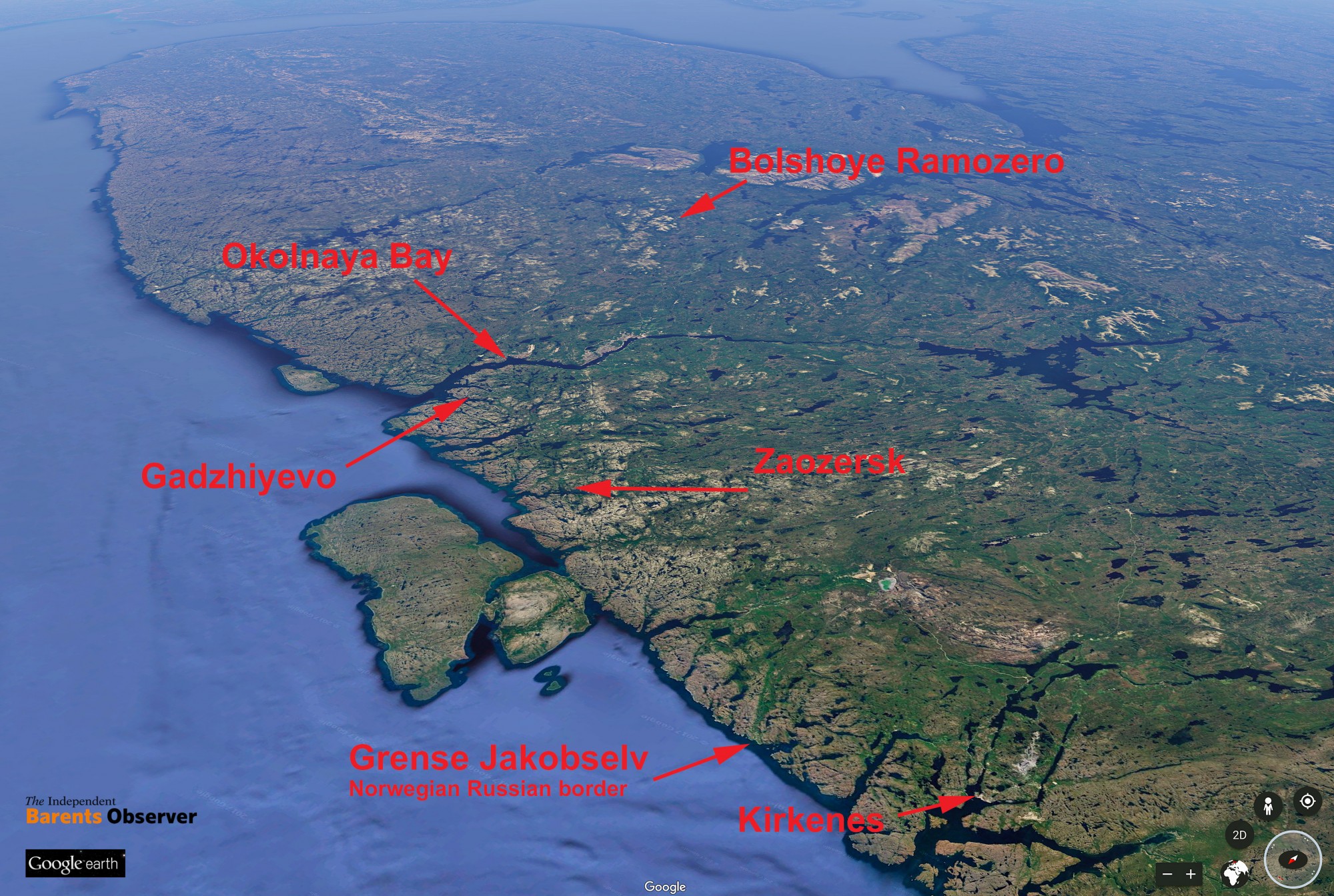
Satellite images show expansion of nuclear weapons sites on Kola
The New START Treaty says USA and Russia must limit the numbers of deployed strategic nuclear warheads to 1,550 by February 5, 2018. Over the last two years, Russia has increased the number of deployed warheads and is now 215 over the max limit to be reached.
There are extensive construction work at two of the Northern Fleet’s facilities for storage of warheads and ballistic missiles for submarines (SLBM) on the coast of to the Barents Sea. The Barents Observer has studied satellite images of the Kola Peninsula open available via Google Earth, combined with open-source data on numbers of nuclear warheads in Russia. The results are frightening.
Expansion of the two base-level storages in Okolnaya Bay near Severomorsk and Yagelnaya Bay in Gadzhiyevo are clearly visible. At both locations, new reinforced bunkers, auxiliary buildings and infrastructure partly finished and partly still under construction can be seen.
The satellite images, however, only reveal what is visible on the surface. Most of the actual warheads are underground.
What now takes place in regard to submarine-launched ballistic missiles’ facilities hasn’t been seen at the naval bases on Kola since the large-scale infrastructure construction to support the Typhoon submarines at the Nerpichya base in Zapadnaya Lista happened in the 1980s.
There are four storages for nuclear weapons on Kola. From satellite images, these storages are not too difficult to find. All are surrounded by double or triple layer barrier of barbed wire fences with extraordinary security at the single entry-exit checkpoints. Also inside the outer fences, the different sections of the facilities are separated with similar security fence barriers. Comparing satellite images with photos posted on internet by naval officers or their family members makes it possible to get a pretty good impression of the current situation.
Several of the storage locations are visible on photos, although mainly in distance, available by searching Yandex, Russia’s own search engine. Also, Wikimapia, an online editable map where people can mark and describe places, has been a good source to information when writing this article.
Zaozersk is the nuclear weapons storage nearest to Norway in a distance of 65 kilometers to the border in Grense Jakobselv. The Norwegian town of Kirkenes is 94 kilometers away. Distance to Finland is 120 kilometers. All four storage sites on Kola are within a radius of 190 kilometers from Norway and 180 kilometers from the Finnish border.
ADVERTISEMENT
Gadzhiyevo submarine base
The image below shows Yegelnaya Bay, better known as Gadzhiyevo naval base. This is likely Russia’s most important location for naval strategic nuclear forces. The base is homeport to the fleet of six Delta-IV submarines and the «Yury Dolgoruky» of the Borei-class. Soon, at least three more Borei-class submarines will get Gadzhiyevo as homeport.
It is possible to date the image to late summer 2016 by counting the 81 reactor compartments stored in the nearby Saida Bay where also the “Itarus” transport barge can been seen. This barge was tranferred from Italy to the Kola Peninsula last spring.
At the jetty in the bay, a Delta-IV class submarine is visible dockside the crane for loading and unloading ballistic missiles. The missiles are driven to the jetty from the storage in the valley behind where both the original storage and the new under construction are visible. The nuclear warheads are, for the most, stored inside the mountain to the left.

Three new reinforced bunkers and five similar bunkers under construction are visible. In the end of the valley, the entrance to an underground storage can be seen. The entrance to another underground storage is visible also at the first nuclear weapon storage facility. A nuclear missile transit hangar is located on the road towards the loading jetty.
How many missiles and warheads that are stored in Gadzhiyevo is not available information to be found in open sources.
Senior Researcher Kristian Åtland with the Norwegian Defence Research Establishment confirms to the Barents Observer that modern ballistic missiles can carry more warheads than older ones.
«In recent years, there has been a slight but steady increase in the number of nuclear warheads deployed on Russian intercontinental ballistic missiles (ICBMs), submarine-launched ballistic missiles (SLBMs) and missiles carried by long-range bomber aircraft. The number of delivery vehicles, ballistic missiles and heavy bombers, has remained fairly constant since 2011, but the new and modernized Russian ICBMs and SLBMs can carry more warheads per missile than the missiles that they replace, hence the increase in the total number of deployed warheads.»
A report from last year written by Steinar Høibråten and Hanne Breivik with the Norwegian Defense Research Establishment says the Delta-IV class submarines are likely to carry the R-29RMU Sineva missile that can hold six nuclear warheads, but it is believed to hold four, each with an explosive yield of 100 kt. An upgraded version of the Sineva missile, named R-29RMU2, is also likely on board the Delta-IV submarines, together with the older version. These missiles can carry up to 10 smaller warheads, or four larger. It is unclear how many of the new Bulava missile, to be carried by the Borei-class submarines, that will be stored in Gadzhiyevo.
The main Bulava storage is under construction in Okolnaya Bay near Severomorsk, a three hour sailing from Gadzhiyevo.
Okolnaya Bay
In 2013, construction of the first storage for 100 Bulava missiles started at the Northern Fleet’s main munition depot in Okolnaya Bay across the waters from Severomorsk north of Murmansk. Quoting Izvestia, the Barents Observer reported that the new storages would cost 450 million rubles. When all Borei-class submarines that carries the Bulava are put in service around 2020, three Bulava storages would be in place with 200 missiles. It is Russia’s Federal Agency for Special Constructions (Spetsstroy) that is responsible for the construction work.
Satellite images show the cliff with the entrances to the underground storage for nuclear weapons. Also, the new bunkers further up the valley are visible. A jetty where nuclear ballistic missiles can be loaded or unloaded to submarines is located by the end of the road in the upper right corner of the image. A new jetty under construction can bee seen in just across the bay from Severomorsk. The Northern Fleet recently got a new transport vessel for the new Bulava-missiles.The vessel «Akademik Kovelyov» can also sail Bulava-missiles to and from Okolnaya Bay and the naval yards in Severodvinsk by the White Sea.
When a ballistic missile submarine is on patrol mission, the on board launchers are normally loaded with both missiles holding real nuclear warheads, but also dummy missiles aimed for test-launching. In between patrols, the submarines can change missiles, replace dummy missiles with real ones or vica-versa. Also, missiles are supposed to be taken out when a submarine is to be docked for repair or maintenance. When missiles are taken out from the launchers they are brought from the jetty to the storage facilities like in Okolnaya Bay.
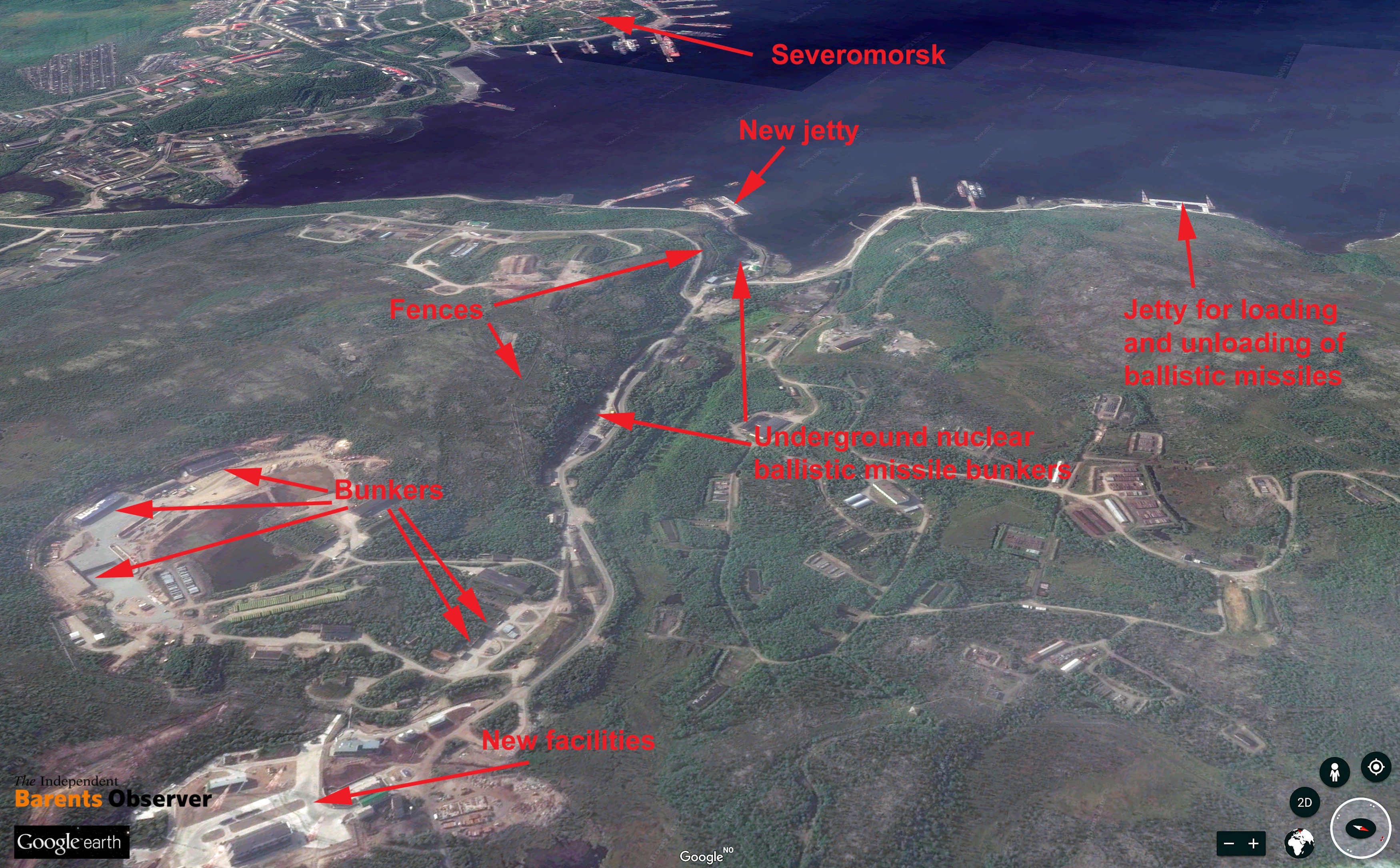
Naval nukes more important
With more Borei-class submarines put in operation, in addition to prolonging the life-time of the six Delta-IV submarines, a larger portion of Russia’s ballistic missiles will be sailing out into the Barents Sea. Later this year, the first of the upgraded Borei-class submarines, the «Knyaz Vladimir» will be floated out from the yard in Severodvinsk, the Barents Observer recently reported. In difference from the first three Borei-class submarines already in service that are armed with 16 missiles, the following five submarines under construction are to be armed with 20 ballistic missiles each. One missile carries six nuclear warheads.
With a total of up to 120 warheads on each vessel, the Russian navy hasn’t seen anything like since the giant Typhoon submarines sailed the Arctic waters during the Cold War. A new American report now suggests that even more than the known eight Borei-class vessels are to be built. «Expectations are emerging that Russia will order another four Borei SSBNs for a total fleet of 12 boats, the same number of SSBNs planned by the US Navy,» writes the two nuclear weapons experts Hans M. Kristensen and Robert S. Norris in the report published in the Bulletin of the Atomic Scientists.
Kristensen and Norris are known to be some the best analysts on Russian nuclear weapon stockpiles outside the military and intelligence structures. Four additional Borei-class subs will add up to 480 more warheads to the fleet, and given that Russia and the US stay firm with the New START agreement, the implication is that the strategic importance of the ballistic missile submarine fleet will increase and make it more significant to Russia’s adversaries.
In late 2015, President Vladimir Putin said in a speech to the expanded meeting of the collegium of the Defense Ministry in Moscow that «new nuclear weapons should go to all parts of the nuclear triad; air, sea and land forces.» The president continued «Particular attention should be paid to strengthening the combat potential of the strategic nuclear forces.»
The Borei-class will in the longer run replace today’s fleet of Delta-III (Pacific fleet) and Delta-IV (Northern fleet). With eight Borei submarines, the number of strategic warheads will be a maximum of 888; three with 16 missiles and five with 20 missiles. Given that the information about additional four Borei subs with 480 warheads is correct, the total number would then be as much as 1,388. In practice, not all Borei’s will be deployed at the same time due to maintenance and repair work. Also, some of the missiles are likely to carry dummy warheads for test-launchings.
However, as least 1,000 of Russia’s strategic nuclear warheads could theoretically be depolyed at sea at any time.
Today, Kristian Åtland estimates that around 60 percent of Russia’s more than 700 sea-based strategic nuclear warheads are concentrated on the Kola Peninsula, whereas the remaining 40 percent is based with the Pacific Fleet at Kamchatka.
«The numerical increase in Russia’s strategic nuclear arsenal, including the part of it that is based on submarines operating from the Kola Peninsula, is neither dramatic nor unexpected. The increase is to be understood in the context of Russia’s long-standing and still on-going defense modernization. The modernization of Russia’s strategic nuclear forces has been a key priority in the State Armaments Program for the period up to 2020 (“GPV-2020”), which was launched in 2010. In addition, the general deterioration of Russia’s relationship with the West, particularly since 2014, seems to have led to a renewed focus on the issue of nuclear deterrence, in Russia as well as in the United States,» Åtland elaborates.
Gorbachev called for nuclear-free zone
2017 marks the 30-years anniversary since Michael Gorbachev’s famous Murmansk-speech on October 1st 1987 where he called for a nuclear-free zone in Northern Europe. Since then, the numbers of nuclear warheads based on the Kola Peninsula saw a continuing decrease until 2015, five years after Barack Obama and Dmitry Medvedev signed the New START Treaty in Prague. In July 2015, Russia reportedly had less deployed strategic nuclear warheads than the United States, 1,582 versus 1,597, the Bureau of Arms Control with the U.S. Departement of State reported.

215 over New START Treaty limit
Latest exchange and verification numbers from the same bureau dated April 1, 2017 shows that Russia now has 1,765 versus the United State’s 1,411. In other words; Russia has 215 warheads more than the maximum set to be achieved nine months ahead. The questions is whether Moscow is likely to dismantle over 200 warheads in less than a year.
Katarzyna Zysk, Associate Professor with the Norwegian Defense University College, says to the Barents Observer that Russia has a vested interest in maintaining the New START agreement. «Russia has a vested interest in maintaining the New START given that it keeps the development of the US strategic nuclear capabilities under control, provides Russia transparency measures and valued insight into to the US nuclear forces, thus increasing predictability,» she says, but underscore that the numbers must down.
«In order to meet the New START Treaty limits when it enters into effect in February 2018, Russia will have to decrease the numbers. However, Russia has been moving toward meeting the obligations as the number of Russia’s deployed strategic warheads has been decreasing compared with 2016. The US is now below the treaty limit and is in fact increasing the number of strategic deployed warheads,» Zysk explains.
Åtland agrees and underscores that today’s numbers do not constitute a treaty violation.
«The fact that Russia is now above the maximum warhead limits of the new START Treaty, which entered into force in 2011, does not in itself constitute a treaty violation. The treaty does not mandate any particular schedule for reductions other than that the agreed-upon limits must be met by February 2018, which is in nine months from now. Reductions in the number of deployed warheads are fairly easy to achieve once the political will is there, either by phasing out old delivery platforms or by removing deployed warheads to central storage. Thus, the identified “peak” may be temporary,» Åtland says. He hopes both the United States and Russia will work towards an extension of the Treaty.
«Hopefully, Russia will stand by its commitments under the current START Treaty regime. In any event, it is important that Russia and the U.S. continue to exchange data about the status of their nuclear arsenals and that they provide for mutual inspections and other transparency measures outlined in the START Treaty and other documents. The parties should also work towards an extension or replacement of the Treaty when it expires in February 2021.»
«Just another bad deal…»
In his first phone talk as president with Russia’s Vladimir Putin, Donald Trump in February denounced the treaty, Reuters reported two U.S. officials with knowledge of the call saying. In another interview with Reuters, President Trump said the New START Treaty is «a one-sided deal.» «Just another bad deal that the country made, whether it’s START, whether it’s the Iran deal… We’re going to start making good deals,» the American president said.
Additional to the deployed strategic warheads are the warheads in reserve and in centralized stockpiles. Kristensen and Norris with the Federation of American Scientists estimate that Russia has a a reserve of 2,390 non deployed warheads and another 4,300 in centralized stockpile, including an estimated 2,700 retired warheads awaiting dismantlement. In total, that is around 7,000 nuclear warheads deployed or stored at different locations in Russia.
Katarzyna Zysk explains why nuclear weapons are so important for Russia.
«The main mission of nuclear weapons in military strategy is to deter and defeat potential enemies that are military superior to Russia, such as the US/NATO or China. Russia differentiates between three types of conflict: local, regional and large-scale, and nuclear weapons are intended to play a role in each of them. For instance, in a local conflict, such as Ukraine, the nuclear weapons are to deter potential opponents from intervening in the conflict; in a regional war with NATO or China, with the threat to use nuclear weapons, Russia intends to keep the war from expanding, also by employing nuclear weapons at an early stage in a conflict - “the escalate to de-escalate” - although to what extent it is credible and realistic is debatable,» Zysk says.
She also estimates Russia’s full stockpile of nuclear warheads to be around 7,000.
Post-post Cold War geopolitics
Professor Rasmus Gjedssø Bertelsen with the Department of Sociology, Political Science and Community Planning with UiT – The Arctic University of Norway says the Kola Peninsula remains crucial for Russian submarines’ access to open seas. He explains how the Arctic for centuries has been an integrated part of the international political, economic and security system.
«Today the Arctic is defined by globalization and post-post-Cold War geopolitics between Russia and the West. And strategic nuclear weapons remain a crucial aspect to great power geopolitics. Russia’s great power status is greatly based on its nuclear capabilities and the nuclear strategic balance between the USA and Russia. Nothing has changed concerning this strategic nuclear balance. And the geo-strategic position of the Arctic has not changed either. So the Kola Peninsula remains crucial for Russian open sea access for strategic nuclear submarine forces and the air and surface assets to protect these strategic nuclear submarines,» Gjedssø Bertelsen says to the Barents Observer.
Russia’s great power status is greatly based on its nuclear capabilities and the nuclear strategic balance between the USA and Russia. Nothing has changed concerning this strategic nuclear balance.
He calls on the younger generation to understand the mechanism of nuclear deterrence established during the Cold War and the Arctic’s important role.
«The public, media, academia, governments and politicians must be aware of this geo-strategic constancy, which deeply affects the Arctic, but is not determined by the Arctic. As a professor of Arctic international politics, I notice that younger colleagues and students often do not have the Cold War nuclear interest, knowledge or skill set. I am just old enough (42) and lived in Iceland in the 1980s experiencing the Cold War Keflavik base to remember that history. Managing the potentially cataclysmic technology of nuclear weapons in stable relationships of deterrence and arms control is a supremely intellectual challenge. It is therefore very important that we maintain and develop that knowledge and skillset among students, young researchers, politicians, officials and others although it may seem obsolete. The silent service continues, although we may not hear it,» Rasmus Gjedssø Bertelsen elaborates.
«Our policies are totally inadequate»
Former US Secretary of Defense, William J. Perry, wrote an opinion published by The Hill in late April where he called on the current administration to give the highest priority to develop policies that recognize the new reality.
«A chilling return to Cold War nuclear dangers in addition to the more recent possibilities of nuclear terrorism and regional nuclear conflicts lead me to conclude that the likelihood of a nuclear catastrophe today is greater than it was during the Cold War. One thing is very clear: our policies are totally inadequate for dealing with these existential dangers,» Perry writes.
Zaozersk - Zapadnaya Litsa
During the last decade of the Cold War, a huge ballistic missile depot was built inside the mountain as part of the Nerpichya submarine base in the Zapadnaya Litsa fjord. This is the westernmost of the naval bases on the Kola Peninsula and was dedicated to the six giant Typhoon submarines, each capable of carrying 200 nuclear warheads.
There are no more Typhoon submarines in the Litsa fjord, but the nuclear weapons storage remains.
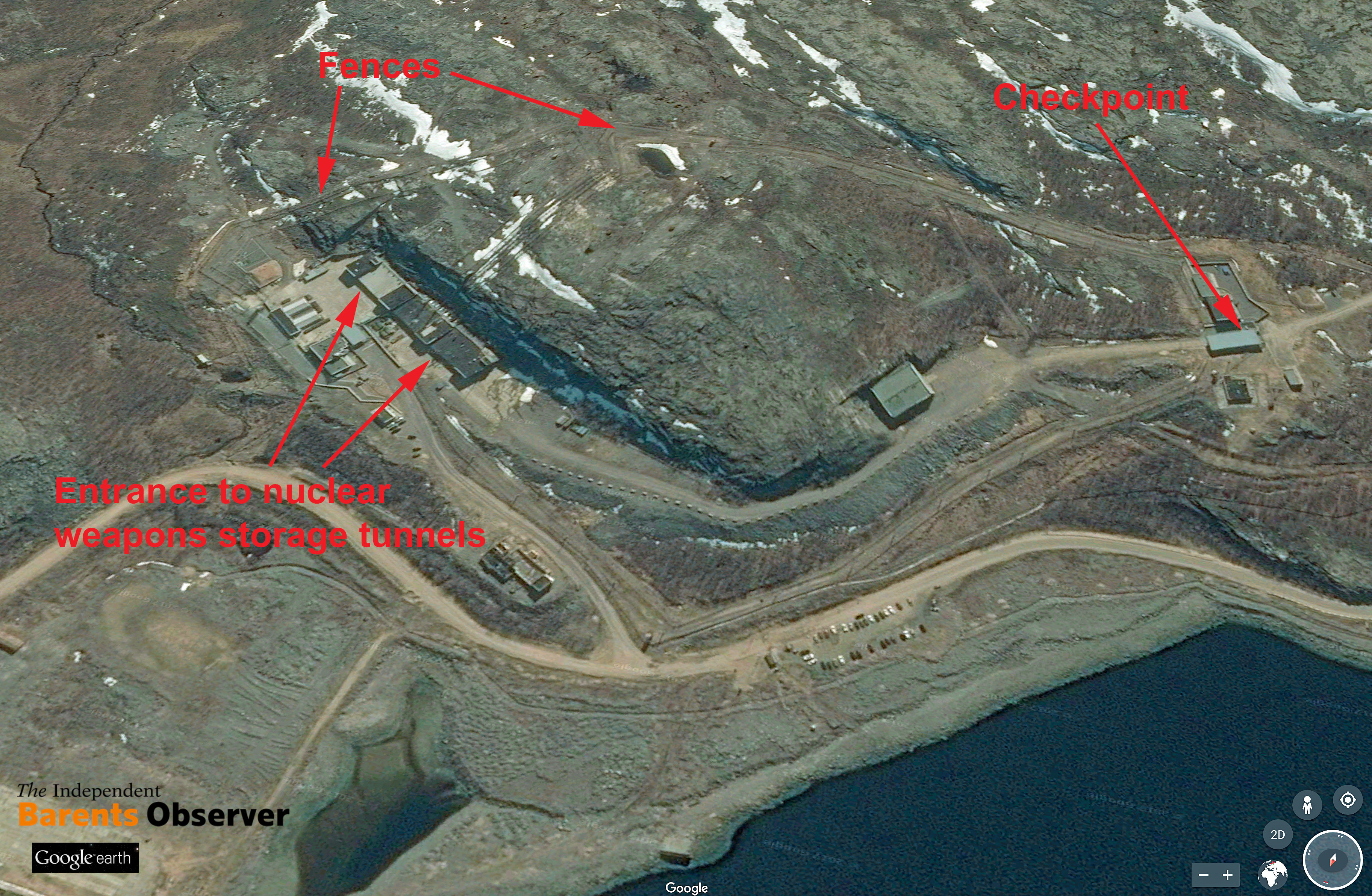
Satellite images clearly show that the storages are still in use. More than 30 cars are parked downside from the entrance to the facilities. At the pier in Nerpichya, one Delta-IV submarine and one Oscar-II submarine are visible at the pier with a floating crane (see image below). As seen from the double barbed wire fences, the storage site are divided into two, each with a separate entrance-exit checkpoint. The two checkpoints have roofs similar to checkpoints at the naval storages in Okolnaya Bay and Gadzhiyevo and the national storage site in Bolshoye Ramozero.
What the differences are between the two storages in Zaozersk is not known. Both have individual entrances to tunnels in the mountain. Judging from the rock dumps by the seaside, downhill from the facilities, the mountain tunnels are likely very big.
Norway pays for nuclear safety
While nuclear weapons are stored inside the mountain on the east side of the Litsa fjord, huge amounts of nuclear waste are stored just two kilometers away, across the fjord in the infamous Andreeva Bay. Thousands of cubic meters of solid radioactive waste and nearly 22,000 spent nuclear fuel elements from submarine reactors are stored here. Neighbouring Norway, along with other donor countries, have spent hundres of millions kroner (tens of millions euros), on nuclear safety projects aimed at upgrading the infrastructure in Andreeva Bay.
On June 27, Norway’s Minister of Foreign Affairs, Børge Brende, travels to Andreeva Bay to mark the first shipping of spent nuclear fuel out of the area, a job that is likely to continue for more than five years. Meanwhile, Russia continues to spend huge amounts of money on new nuclear weapons in the border areas.
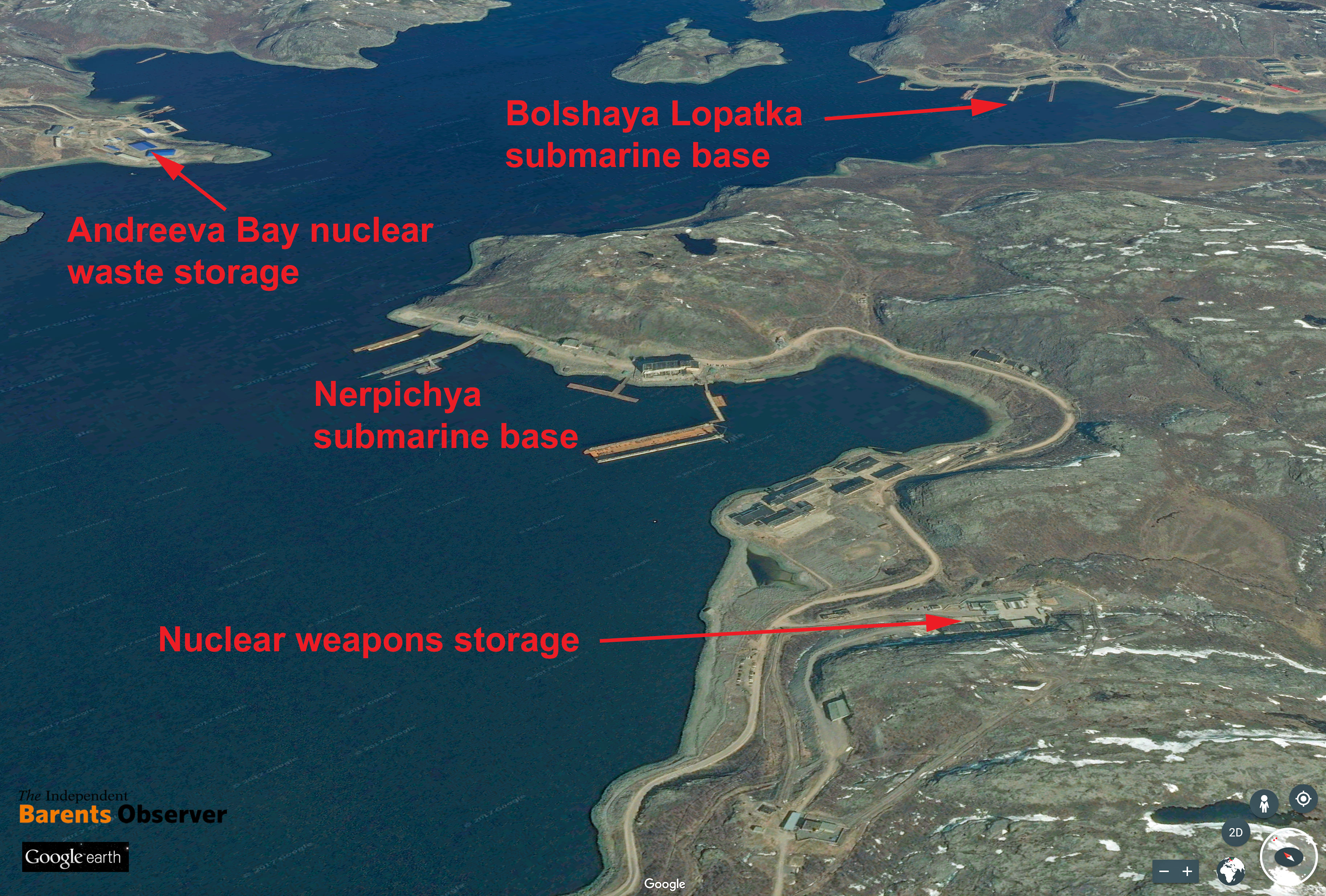
Bolshoye Ramozero - the most secret
The most secret of all secret nuclear weapons storages on the Kola Peninsula is located some 20 kilometers to the northeast of the mining town Olenegorsk, on a side road towards Lovozero. The location, diffcult to find referances to on the internet, has several names; Katalya is one, Bolshoye Ramozero is another (the nearby lake). Like other secret towns in the Soviet Union, also this one had a post-code name; Olenegorsk-2. The nickname is Tsar City, allegedly because of the priviliges the inhabitants had. The town is also simply known as Military Unit 62834 or Object 956.
While it is easy to find selfies and blogposts from most Russian military garrisons and bases, few can be found from this town. Not too strange; the town is under full supervison of the 12th Chief Directorate of the Ministry of Defense. This directorate is responsible for all of Russia’s nuclear weapons, including storages, technical maintenance and transportation.
The 12th Chief Directorate is probably the most secretive organization in the Russian Armed Forces, even more than the foreign military intelligence agency GRU and the strategic missile forces, according to Wikipedia.
Bolshoye Ramozero serves a national-level nuclear weapons facility, one of 12 such storages across Russia, according to a recent report written by Pavel Podvig and Javier Serrat. The report, focusing on non-strategic nuclear weapons in Europe, is published by the United Nations Institute for Disarmament Research (UNIDIR).
It is believed that all non-strategic nuclear warheads possible aimed for naval, air force and army weapons for the Kola area, and maybe even more, are stored at the central national level storage in Bolshaya Ramozero. According to the UNIDIR report, the 12th Chief Directorate is responsible for providing the nuclear warheads to the different military units “when deemed necessary.” If a threatening situation occurs, warheads can be transported by trucks from this site to the different military units on the Kola Peninsula which holds weapons systems that could be armed with tactical nuclear weapons, like naval cruise missiles or torpedoes, or cruise missiles carried by aircrafts.
The nearest airbase to the central storage on Kola is Olenogorsk where Tu-22 bombers are stationed.
Inside the underground storage bunkers in Bolshaya Ramozero are only the warheads stored.
Satellite images show that there are two storage areas just north of the town. The first area has three internal sites, of which only two seems to be actively used. The second area is located another kilometer further north.
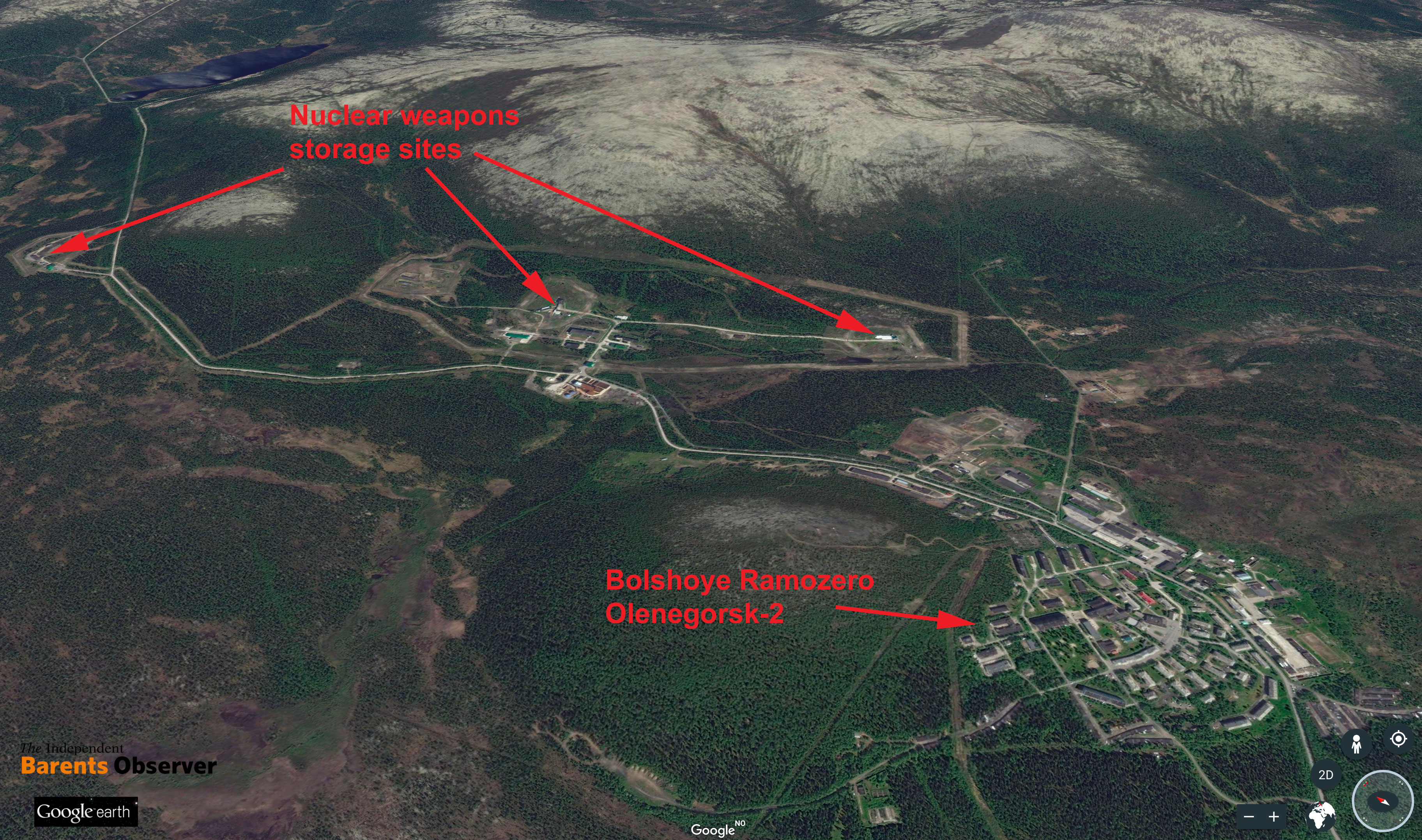
Interested in more articles on military and security issues? See Barents Observer’s dedicated Security Section.
You can help us…
…. we hope you enjoyed reading this article. Unlike many others, the Barents Observer has no paywall. We want to keep our journalism open to everyone, including to our Russian readers. The Independent Barents Observer is a journalist-owned newspaper. It takes a lot of hard work and money to produce. But, we strongly believe our bilingual reporting makes a difference in the north. We therefore got a small favor to ask; make a contribution to our work.
The Barents Observer Newsletter
After confirming you're a real person, you can write your email below and we include you to the subscription list.


